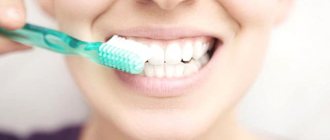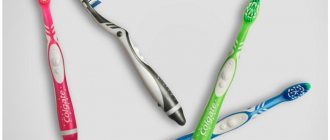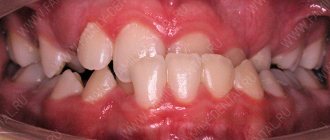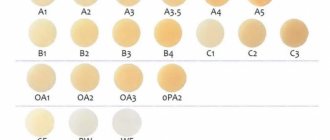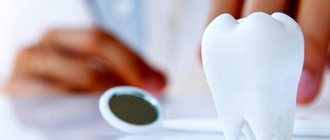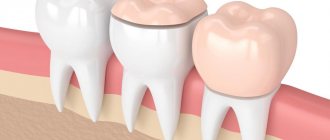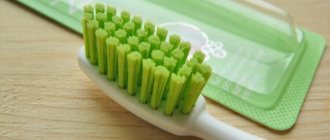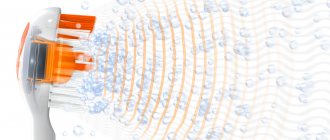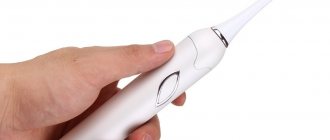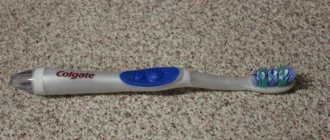The quality of oral care determines the health of teeth, their protection from the influence of cariogenic microbes, the absence of an unpleasant odor, as well as the whiteness and beauty of a smile. To keep your mouth clean, you need a reliable companion – a toothbrush. The characteristics it has determine how atraumatically and efficiently the enamel will be cleaned. What takes better care of your teeth: a soft toothbrush or a hard one? How to choose the right dental assistant? Let's take a closer look at these issues.
Toothbrush material
Almost all modern brushes are made from nylon fibers. Previously, hygiene products were produced with bundles of animal hair. And the first prototypes of modern dental devices, invented in Ancient Egypt, generally consisted of disintegrated plant branches.
Dentists say that it is necessary to buy only synthetic brushes, explaining that natural materials are highly hygroscopic, and this leads to the proliferation of pathogenic bacteria in the villi of the brushes. Another disadvantage of natural bristles is excessive fragility, which leaves sharp edges that can injure the enamel.
What shape and size should a toothbrush be?
Toothbrushes are available in different sizes and head shapes. Please note the following features:
- The head should cover a maximum of 2-2.5 teeth. Only in this case will cleaning be effective. The head is too large and does not allow the bristles to penetrate into the interdental spaces.
- The length of the toothbrush head for children should be 18-25 mm, and for adults - 30 mm maximum. The child’s teeth are just growing, the jaw is not yet formed, so the large head can injure the gums. Small brushes are not useless for an adult, but brushing teeth with them is inconvenient. In addition, you will have to spend a lot of time on the procedure.
- The head should have a rounded shape to minimize the risk of injury to the oral mucosa.
- The area connecting the head with the handle must be movable so that the spring effect is triggered, due to which the pressure on the teeth and gums is reduced. Almost all modern brushes have a flexible neck to control pressure.
Brushes differ in the number of tufts. The larger the head, the more bristles it is equipped with. Children under 6 years old need to choose models with 23 bundles, teenagers - with 30-40, adults - with 45-55 bundles. People with braces should have a multi-tuft brush (more than 55). Their number is indicated on the packaging. It is not always possible to quickly find this parameter among the information written in small print. However, the quality of teeth cleaning depends on this, so it is better not to ignore this feature of the brush.
As for the handle, it just needs to be comfortable. It is advisable to choose a model with a rubberized coating that will not slip out of your hand.
What determines the choice of hardness level?
There are five degrees of hardness:
- very soft;
- soft;
- average;
- hard;
- very tough.
The choice of hardness level is influenced by various indicators:
- Age. Children are advised to buy toothbrushes with soft bristles . This requirement is due to the immaturity of dental tissues for several years after teething.
- Periodontal condition. For healthy gums, it is optimal to brush your teeth with a product of medium hardness. But if the patient notices bleeding, loose gums, mobility of teeth or ulcerations on soft tissues, then it is better to choose a soft toothbrush.
- Availability of prostheses and orthodontic structures. When wearing artificial products in the mouth, dentists recommend using devices with hard bristles to improve hygiene.
- Hyperesthesia. If your teeth are sensitive, cleaning with an ordinary brush can be a real torture. Products with soft bristles are suitable for such people.
What to consider when buying a brush
The choice of brush hardness will be influenced not only by the condition of the oral cavity and teeth, but also by other factors.
- age: soft brushes are used by children and elderly people who have any problems with their teeth; the rest use a medium or hard brush.
- condition of the oral mucosa and gums: in case of pathology, you need to purchase soft bristles;
- presence of dentures or braces: the mouth needs to be cleaned more thoroughly. And only a hard brush can do this;
- condition of the enamel: if it is thinned, you should use a soft brush, in other cases - a hard one.
Which brush to use for brushing your teeth - hard, soft or medium (medium) - will depend solely on your sensations, the condition of your oral cavity and concomitant diseases. The “golden mean” has always been considered the optimal solution, but in any case you should definitely consult a dentist.
Who should use a soft toothbrush?
A soft-bristled toothbrush is recommended:
- children under 10-12 years of age;
- people who suffer from bleeding when brushing their teeth;
- patients with diabetes mellitus;
- in case of blood clotting disorders;
- with third degree tooth mobility;
- with pathological abrasion and wedge-shaped defects;
- for periodontal diseases.
In addition to the degree of hardness, it is necessary to pay attention to the technique of cleaning the tooth surface. Sometimes the wrong technique can harm hard tissues.
How to choose a brush based on the shape of the bristles
The bristles of a toothbrush can be single-level, two-level, three-level and multi-level. Research shows that multiple levels of bristles provide better cleaning between teeth and gum pockets.
Based on the arrangement of the beams, three types of brushes are distinguished:
- Hygienic: with even and straight bundles of the same length. This is a very ordinary brush with minimal functionality. Usually such models are bought for children.
- Preventive: the beams are located in different directions, have different lengths and even rigidity. There may be rubber bristles on the sides of the brush that massage the gums while brushing your teeth.
- Special: designed for cleaning braces, implants and other structures. Such brushes are sold in pharmacies and can be made to order. It is better to buy them after consulting a dentist.
These are the main parameters of toothbrushes. Today, many models are available with additional functions. If you wish, you can choose a good brush that will massage your gums, clean your tongue, etc.
Are there any contraindications?
There is no list of contraindications for using a soft toothbrush, however, this does not mean that such a device cannot harm your teeth. The main disadvantage of soft bristles is that the degree of cleaning of the enamel is not good enough compared to normal or hard bristles.
Don't use a soft toothbrush:
- with a tendency to increased stone formation and accumulation of dental plaque;
- people who smoke;
- persons with a completely healthy oral cavity;
- with crowded teeth.
The use of soft bristles products for hygiene in such people is undesirable due to inadequate cleaning of the tooth surface and the likelihood of leaving plaque behind.
Varieties
Stay up to date! According to their purpose, toothbrushes are divided into:
- classic. Recommended for daily hygiene. These include products indexed medium and hard;
- therapeutic and preventive. Used for specific areas of the oral cavity. A good choice would be products with combined bristles;
- highly specialized. They are used to care for dentures and various orthodontic structures (braces). For these purposes, products marked extra hard are used.
For your information! According to the type of action, devices are divided into:
- classic mechanical. When used correctly, they quickly and effectively remove food debris and other contaminants. Their advantages include: affordable cost, simplicity and ease of use;
- electric with a moving head. They operate from a small built-in motor and are often equipped with a timer. Their positive aspects include saving free time and effort when brushing your teeth. They effectively soften and remove plaque thanks to their reciprocating and rotating movements. In most models, you can independently adjust the speed of rotation of the head;
- sound. They appeared on the market relatively recently and work using sound waves. In such models, the bristles rotate at a speed of 24 thousand revolutions per minute and penetrate even the most inaccessible places;
- ultrasonic. Their operating principle is very different from other models. Using a sound wave, they destroy plaque, eliminate gum inflammation, and neutralize pathogens. They are able to penetrate into the deepest and most distant places of the tooth surface. Their advantages include gentle cleansing of the oral cavity and elimination of unpleasant odor. But such a brush can be used no more than 2-3 times a week. It is contraindicated for people suffering from epilepsy and heart disease.
Regular or electric soft toothbrush?
An electric toothbrush allows you to provide better oral care. This is due to the small size of the working part, due to which it is able to penetrate into hard-to-reach areas of the oral cavity. In addition, the electric device performs not only reciprocating movements, but also circular ones, and modern models are supplemented with a pulsating rotation mode.
Children love to brush their teeth with electric brushes. This makes them feel more grown-up and also makes oral care a fun game. Electric dental devices often come with soft attachments that are intended for children.
There are situations where using a battery-powered brush can be harmful:
- Severe tooth mobility.
- Recovery period after surgery on soft tissues of the oral cavity.
- Stomatitis.
- Hypertrophic gingivitis.
- Malignant neoplasms.
If you are prone to abrasion of enamel, you should alternate between a soft manual toothbrush and an electric one.
How often to change the brush
Doctors recommend changing the brush for an adult every 2-3 months, for a child - a month after the first use. Even if it is in excellent condition, it will still have to be thrown away. Brushes often fail prematurely because they are not always handled with care. They need to be replaced if they become shaggy, the bristles fall out and delaminate. Using them is useless and dangerous, as you can injure your gums and enamel.
Nozzles from electric brushes last a little longer - up to 4 months. Some have a wear indicator. If the blue hairs start to lighten, it's time to replace the device head.
Review of the most popular models
The assortment of every manufacturer producing oral hygiene products includes models with soft tufts.
Let's consider the most popular:
- SPLAT Professional Sensitive - the villi are split into four parts, each of which is rounded to avoid injury. The bristles are impregnated with silver ions, which protect against bacterial attack on the teeth.
- LACALUT Sensitive - equipped with soft bristles that protect tooth enamel from damage and gently cleanse the oral cavity.
- Colgate 360 Sensitive Pro-Reliev - in addition to the fine bristles, there is a tongue brush on the back of the head. Among the tufts there are rubber cups that allow you to polish the tooth surface.
- Jordan Target Sensitive - has a small working part, which makes it possible to penetrate well into the back of the mouth. Ultrasoft bristles have a diameter of 0.01 mm.
How to determine hardness when purchasing?
to determine the rigidity of the device by its packaging. It must indicate the hardness indicator (medium, hard, extra hard).
Reference! The degree of rigidity is also determined by the diameter of the fibers. The larger their diameter, the stiffer the brush will be.
There are 4 degrees of bristle stiffness : hard, soft, medium (medium) and very soft. The best option is a model with hard pile, which is suitable for people of different age categories.
Hard brushes , in turn, are divided into :
- medium degree of hardness . They are the most popular and are used by most of the adult population. They are intended for a healthy oral cavity;
- hard . They are recommended for use by heavy smokers and coffee lovers. They are excellent at fighting plaque formation;
- super hard (extra hard). They are recommended for use when cleaning dentures and braces.
Most models are additionally equipped with silicone inserts on the back of the working head. They are intended for polishing teeth, cleaning the tongue or massaging gums.
Is it possible to make a toothbrush soft?
If your new brush is too hard for you, there are ways to soften your toothbrush:
- Place the head under running hot water.
- Gently knead the stubble with your fingers.
- Place the brush in a container of warm vinegar for half an hour.
Still, the most correct thing in this situation would be to purchase a new brush with different, softer bristles.
The choice of a toothbrush must be approached consciously, because the level of oral care, prevention of caries and gum disease depends on its quality. In order not to damage the enamel, it is necessary not only to use the right brush, but also to follow the technique of cleaning your teeth. And do not forget that each brush must be replaced after 3 months of use.
Author: Violeta Kudryavtseva, doctor, especially for Mama66.ru
Features of the location of the bristles
More than half a century ago, people used toothbrushes made from both natural bristles and synthetic fibers. Now scientists have proven that it is permissible to use only products with artificial bristles, because a natural brush absorbs moisture, and this provokes the growth of microorganisms.
The end part of the villi is always rounded so as not to scratch the surface of the enamel and soft tissues of the oral cavity. Nylon bristles are grouped in tufts, which are arranged in various ways along the surface of the plastic head. According to the height of the pile, brushes come with a single-level arrangement of elements, two-, three-, and also multi-level.
The beams are fixed to the site in a special way, and can be installed both parallel to each other and at different angles. The difference in location allows for more complete cleansing of all tooth surfaces.
Bristle material
Modern brushes are safe, convenient and effective devices that allow you to daily clean the surface of your teeth from food debris and soft deposits.
A few decades ago, hygiene products with natural bristles were extremely popular, but today everything has changed.
Almost all brushes have synthetic bristles.
It is impossible to find natural fibers among hard models, as they are particularly soft and brittle. Therefore, manufacturers have long switched to artificial materials.
Most often used:
- Nylon;
- Cetron;
- Polyurethane;
- Nerlon;
- Derlon.
These fibers are highly environmentally friendly and can be easily processed, including grinding the ends.
How to properly care for the product
In order for the product to serve you as long as possible, it should be stored properly and kept clean. Here are some basic recommendations in this regard:
- Obviously, each member of the family should have his own brush. Devices can be stored in a cup specially designated for this purpose, but care must be taken that the working areas do not come into contact with each other,
- they should be kept separate from razors and other hygiene items,
- The model for mechanical cleaning and the nozzle for electric/ultrasonic cleaning must be changed every 3 months. After treating caries or mucosal infections, you should buy a new product,
- After each procedure, it is recommended to thoroughly wash the bristles and treat them with soap - leave this until the next cleaning.
Everyone should have their own personal toothbrush.
A closed case is not the best solution for permanent storage. Only if it is not a special ventilated case for an electric or ultrasonic model. Once a week, the product can be placed in an antibacterial bath for disinfection.
